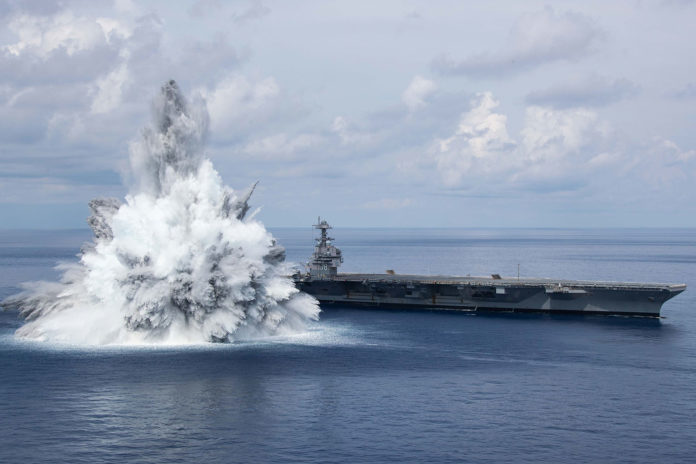The US Navy completed its three-part explosive Full Ship Shock Trials (FSST) on the aircraft carrier USS Gerald R. Ford on 8 Aug. The third blast of the full-ship shock trials, which took place off the coast of Jacksonville, FL, validate a ship’s shock hardness and ability to sustain operations in a simulated combat environment using live ordnance.
During the four-month testing evolution, the first-in-class aircraft carrier withstood the impact of three 40,000-pound (over 18,000 kg) underwater blasts, released at distances progressively closer to the ship. Earlier in June, a similar test was performed successfully and then followed by another one in July.
The Navy designed the Ford-class carrier using advanced computer modeling methods, testing, and analysis to ensure the warships are hardened to meet demanding mission requirements under harsh conditions they might encounter in battle. Rear Adm. James P. Downey, executive program officer for aircraft carriers, was onboard the ship during the first and third shock evolutions and observed the historical trials first-hand.
“FSST has proven a critical investment in the Ford-class development,” said Downey. “The ship and crew performed exceptionally in these very strenuous conditions and continued their operations throughout the shock events, demonstrating the ship’s ‘fight through capability.“
The FSSTs are complex evolutions conducted during a precise operating schedule in compliance with exacting environmental mitigation requirements, respecting known migration patterns of marine life and protected species. Ford’s shock trials were no exception. Before each test, the FSST team notified mariners to avoid the test area and implemented extensive protocols to ensure the safety of military and civilian personnel participating in the operation.
Also, the team of more than a dozen scientists, biologists, and observers used high-powered lenses to detect marine life at great distances through ocean waves and white caps. Several crucial variables were taken into account before each test, including ship and crew readiness, weather, and sea state, as well as pre-set environmental mitigation measures designed to protect any marine life spotted within the test area.
Following the completion of the shock trials, the USS Gerald Ford will now return to the Tidewater area for a six-month Planned Incremental Availability (PIA). As the PIA begins, teams will conduct additional detailed inspections, assess any damage sustained during the shots, and continue modernization and maintenance work in advance of workups for the ship’s deployment in 2022.
